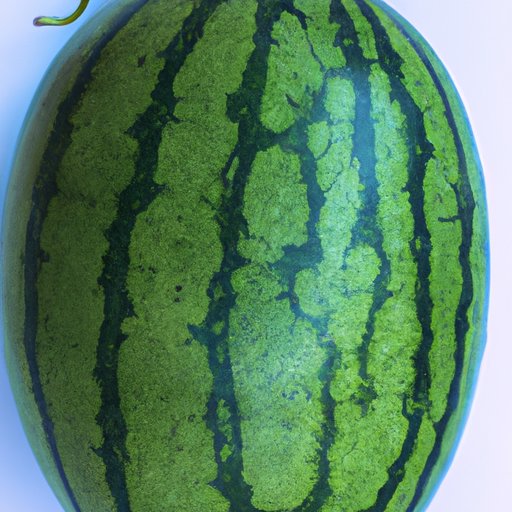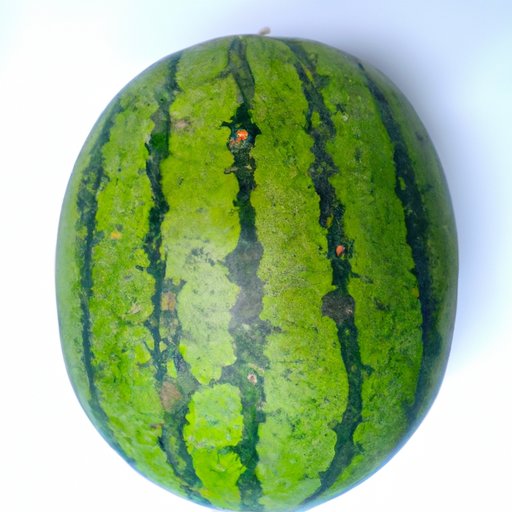
I. Introduction
Have you ever struggled to select a ripe watermelon? You’re not alone. There’s nothing worse than spending your hard-earned money on a watery, flavorless fruit. But fear not, with a little know-how and some expert advice, you too can master the art of selecting a tasty watermelon. In this article, we’ll explore the top tips for picking the perfect watermelon, as well as the ultimate guide to selecting a sweet and juicy one. We’ll also delve into the factors that affect flavor and provide expert advice on how to ask a produce expert for help. So let’s get started!
II. Top 5 Tips for Picking a Perfectly Ripe Watermelon
Let’s start with the basics. Here are our top five tips for selecting a perfectly ripe watermelon:
A. Tip #1: Look for a Uniform Shape and Size
A perfectly ripe watermelon should be symmetrical and uniform in shape and size. Avoid watermelons that have irregular bumps or lumps, as this could indicate that it didn’t grow evenly.
B. Tip #2: Check the Field Spot
The field spot, or the area where the watermelon rested on the ground, can tell you a lot about its ripeness. Look for a yellowish, creamy patch on the underside of the watermelon. If the field spot is white or green, it may not be fully ripe.
C. Tip #3: Examine the Skin
The skin of a ripe watermelon should be firm, smooth, and without blemishes or dents. If there are cuts or bruises on the skin, this could indicate that the watermelon is overripe or damaged.
D. Tip #4: Give it a Tap
Gently tap the watermelon with your knuckles. A ripe watermelon should produce a deep, hollow sound. If it sounds dull or thuds, it may not be fully ripe.
E. Tip #5: Pick it Up
A ripe watermelon should feel heavy for its size. This indicates that it’s full of water and ready to eat. If it feels too light, it may be underripe or dehydrated.

III. The Ultimate Guide to Selecting a Sweet and Juicy Watermelon
Now that you know the basics of selecting a ripe watermelon let’s delve into the ultimate guide for selecting a sweet and juicy one.
A. Understanding Ripeness and Sugar Content
A watermelon is ripe when its sugar content has reached its peak. To determine its ripeness, you can measure its sugar content using a refractometer. However, this tool may not be accessible to everyone, so there are other methods to determine ripeness.
B. Identifying Watermelon Varieties with High Sugar Content
Some watermelon varieties have higher sugar content than others. For example, the Jubilee, Crimson Sweet, and Charleston Gray varieties are known for their sweetness. Look for these varieties when shopping for watermelons.
C. Techniques for Determining Sweetness
Smelling and tasting the watermelon are two techniques for determining sweetness. A sweet watermelon should have a fragrant, tropical aroma. When you taste it, the flesh should be crisp, and the juice should be sweet and flavorful.
IV. Mastering the Art of Choosing the Tastiest Watermelon
Choosing a watermelon with great flavor goes beyond just selecting a ripe one. Here are some factors that affect flavor:
A. Factors that Affect Flavor
The variety of watermelon, growing conditions, and harvest time all affect flavor. A watermelon that was harvested at the right time, grown in optimal conditions, and is of a flavorful variety will have the best taste.
B. Identifying Watermelons with Good Texture and Mouthfeel
A watermelon with good texture and mouthfeel should be firm yet juicy. The flesh should be crisp but not too crunchy or hard. When you bite into it, the juice should burst in your mouth.
C. Evaluating Aroma
The aroma of a watermelon can tell you a lot about its flavor. A ripe watermelon should have a sweet, fruity aroma. If it has a dull or bland smell, it may not taste very flavorful.
V. Expert Advice on How to Identify a Ripe Watermelon
Now that you know the basics of selecting a ripe and flavorful watermelon, let’s dive into some expert advice.
A. Tips from Experienced Watermelon Growers
According to experienced watermelon growers, some of the best watermelons are the ones that grow best in your particular region. Talk to your local growers and ask for their recommendations. They’ll be able to tell you which varieties grow best in your area and when the best time to harvest them is.
B. Common Mistakes to Avoid
One of the most common mistakes people make when selecting watermelons is assuming that size equals ripeness. Remember that size doesn’t necessarily equal quality or ripeness. Another mistake is not inspecting the watermelon thoroughly.
C. How to Ask a Produce Expert for Help
If you’re shopping for watermelons at a grocery store or farmer’s market, ask for help from a produce expert. They will be able to tell you which watermelons are freshest, have the highest sugar content, and are most flavorful.
VI. 5 Signs of a Ripe Watermelon and How to Spot Them
Here are five signs of a ripe watermelon:
A. Sign #1: Uniform Shape and Size
A ripe watermelon should be uniformly shaped and sized without any bumps or lumps.
B. Sign #2: Yellowish Field Spot
The field spot should be creamy yellow, indicating that the watermelon is ripe.
C. Sign #3: A Slightly Dull Skin
The skin should be slightly dull and not too shiny, indicating that it’s mature and ripe.
D. Sign #4: A Hollow Sound
When you tap the watermelon, a hollow sound indicates that it’s ripe and full of water.
E. Sign #5: Heaviness
The watermelon should feel heavy for its size, indicating that it’s full of water and ripe.
VII. The Foolproof Method for Selecting a Ripe and Delicious Watermelon
Now that you know all the tips and tricks for selecting a ripe and delicious watermelon, here’s a foolproof method:
A. A Step-by-Step Process for Evaluating and Selecting Watermelons
First, look for a watermelon with a uniform shape and size. Next, check the field spot to ensure it’s yellowish. Third, examine the skin carefully for blemishes or cuts. Fourth, give it a gentle tap, and listen for a hollow sound. Finally, pick it up to ensure it feels heavy for its size.
B. Expert Tips for Making the Right Choice Every Time
Remember to smell and taste the watermelon before purchasing it. Look for a sweet, tropical aroma and juicy, flavorful flesh. Ask a produce expert for help if needed.
C. Common Mistakes to Avoid
Don’t assume size equals ripeness, and thoroughly inspect the watermelon before purchasing it. Don’t be afraid to ask for help from a produce expert.
VIII. Conclusion
Choosing a ripe, sweet, and juicy watermelon doesn’t have to be difficult or frustrating. By following these expert tips and techniques for selecting the perfect watermelon, you too can enjoy the delicious taste of summer. Remember to look for a uniform shape and size, check the field spot, examine the skin, tap it gently, give it a lift, and smell and taste it before purchasing. With practice and patience, you’ll be a watermelon selecting expert!
Now it’s time to put these tips into action and enjoy the perfect watermelon.




